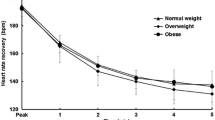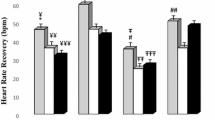Summary
Aim of this study was to evaluate reliable guide values for heart rate (HF) and blood pressure (RR) with reference to defined sub maximum exertion considering age, gender and body mass. One hundred and eighteen healthy but non-trained subjects (38 women, 80 men) were included in the study. For interpretation, finally facts of 28 women and 59 men were used. We found gender differences for HF and RR. Further, we noted significant correlations between HF and age as well as between RR and body mass at all exercise levels. We established formulas for gender-specific calculation of reliable guide values for HF and RR on sub maximum exercise levels.
Zusammenfassung
Ziel dieser Querschnittsstudie war es, zuverlässige ergometrische Richtwerte für die Herzfrequenz (HF) und den systolischen Blutdruck (RR), bezogen auf definierte submaximale Belastungen unter Berücksichtigung von Alter, Geschlecht und Körpermasse bei untrainierten Personen zu erarbeiten. Im Rahmen eines betrieblichen Gesundheitsförderungsprojektes wurden 118 gesunde Personen (38 Frauen, 80 Männer), ohne besondere sportliche Aktivität in der Anamnese, in die Studie eingeschlossen. Statistisch ausgewertet wurden letztlich Daten von 28 Frauen und 59 Männern. Es finden sich sowohl für die HF als auch für den RR Unterschiede zwischen den Geschlechtern. Frauen zeigen auf individuell vergleichbarer Belastung eine höhere HF, während Männer höhere RR Werte aufweisen. Die submaximale HF korreliert, unabhängig von Geschlecht und Körpermasse, negativ mit dem Alter. Es zeigt sich ein positiver Zusammenhang zwischen dem Körpergewicht und dem systolischen RR auf allen Belastungsstufen. Mittels Regressionsanalyse erarbeiteten wir geschlechtsspezifische Formeln zur Berechnung von Richtwerten (mittleren Schätzwerten) für HF und RR im submaximalen Belastungsbereich.
Similar content being viewed by others
Literatur
Wonisch M, Berent R, Klicpera M, et al. Praxisleitlinien Ergometrie. J Kardiologie, 15(Suppl A): 3–17, 2008
Löllgen H, Erdmann E. Ergometrie. Belastungsuntersuchung in Klinik und Praxis. 2. Aufl. Berlin Heidelberg: Springer; 2000
DuBois D, DuBois EF. A formula to estimate the approximate surface area if height and weight be known. Arch Intern Med, 17: 863–871, 1916
Dimkpa U, Ugwu AC, Oshi DC. Assessment of sex differences in systolic blood pressure responses to exercise in healthy, non-athletic young adults. JEPonline, 11: 18–25, 2008
Huxley VH. Sex and the cardiovascular system; the intriguing tale of how women and men regulate cardiovascular function differently. Advan Physiol Edu, 31: 17–22, 2007
Kannel WB, Wolf PA, McGee DL, et al. Systolic blood pressure, arterial rigidity, and risk of stroke. JAMA, 245: 1225–1229, 1981
Stratton JR, Levy WC, Cerqueira MD, et al. Cardiovascular responses to exercise: Effects of aging and exercise training in healthy men. Circulation, 89: 1648–1655, 1994
Daida H, Allison TG, Squires RW, et al. Peak exercise blood pressure stratified by age and gender in apparently halthy subjects. Mayo Clin Proc, 71: 445–452, 1996
Martin WH, Ogawa T, Kohrt WM, et al. Effects of aging, gender, and physical training on peripheral vascular function. Circulation, 84: 654–664, 1991
Dimkpa U, Ugwu AC. Influence of age on blood pressure recovery after maximal effort ergometer exercise in non-athletic adult males. Eur J Appl Physiol, 106: 791–797, 2009
Lakatta EG. Deficient neuroendocrine regulation of the cardiovascular system with advancing age in health humans. Circulation, 87: 631–636, 1993
Sieira MC, Ricart AO, Estrany RS. Blood pressure response to exercise testing. Apunts Med Esport, 45: 191–200, 2010
Tanaka H, Bassett DR, Turner MJ. Exaggerated blood pressure response to maximal exercise in endurance-trained individuals. Am J Hypertens, 9: 1099–1103, 1996
Franz IW. Blood pressure measurement during ergometric stress testing. Z Kardiol, 85(S3): 71–75, 1996
Rost R, Hollmann W. Belastungsuntersuchung in der Praxis. Stuttgart: Thieme, 1982
Miyai N, Arita M, Miyashita K, et al. Blood pressure response to heart rate during exercise test and risk of future hypertension. Hypertension, 39: 761–766, 2002
Zanettini JO, Fuchs FD, Zanettini MT, et al. Is hypertensive response in treadmill testing better identified with correction for working capacity? A study with clinical, echocardiographic and ambulatory blood pressure correlates. Blood Pressure, 13: 225–229, 2004
Laukkanen JA, Kurl S, Rauramaa R, et al. Systolic blood pressure response to exercise testing is related to the risk of acute myocardial infarction in middle-aged men. Eur J Cardiovasc Prev Rehabil, 13: 421–428, 2006
Hedberg P, Ohrvik J, Lönnberg I, et al. Augmented blood pressure response to exercise is associated with improved long-term survival in older people. Heart, 95: 1082–1078, 2009
Singh JP, Larson MG, Manolio TA, et al. Blood pressure response during treadmill testing as a risk factor for new-onset hypertension. The Framingham Heart Study. Circulation, 99: 1831–1836, 1999
Manolio TA, Burke GL, Savage PJ, et al. Exercise blood pressure response and 5-year risk of elevated blood pressure in a cohort of young adults: the CARDIA study. Am J Hypertens, 7: 234–241, 1994
Haber P. Lungenfunktion und Spiroergometrie. Interpretation und Befunderstellung. Wien New York: Springer, 2004
Sandvik L, Erikssen J, Ellestad M, et al. Heart rate increase and maximal heart rate during exercise as predictors of cardiovascular mortality: a 16-year follow-up study of 1960 healthy men. Coron Artery Dis, 6: 667–678, 1995
Wilkoff BL, Corey J, Blackburn G. A mathematical model of the cardiac chronotropic response to exercise. J Electrophysiol, 3: 176–180, 1989
Author information
Authors and Affiliations
Corresponding author
Rights and permissions
About this article
Cite this article
Strasser, B., Schwarz, J., Haber, P. et al. Richtwerte für Herzfrequenz und Blutdruck bei 20, 40, 60 und 80 % der maximalen ergometrischen Referenzleistung unter Berücksichtigung von Alter, Geschlecht und Körpermasse bei untrainierten Personen. Wien Med Wochenschr 161, 550–556 (2011). https://doi.org/10.1007/s10354-011-0023-6
Received:
Accepted:
Published:
Issue Date:
DOI: https://doi.org/10.1007/s10354-011-0023-6




